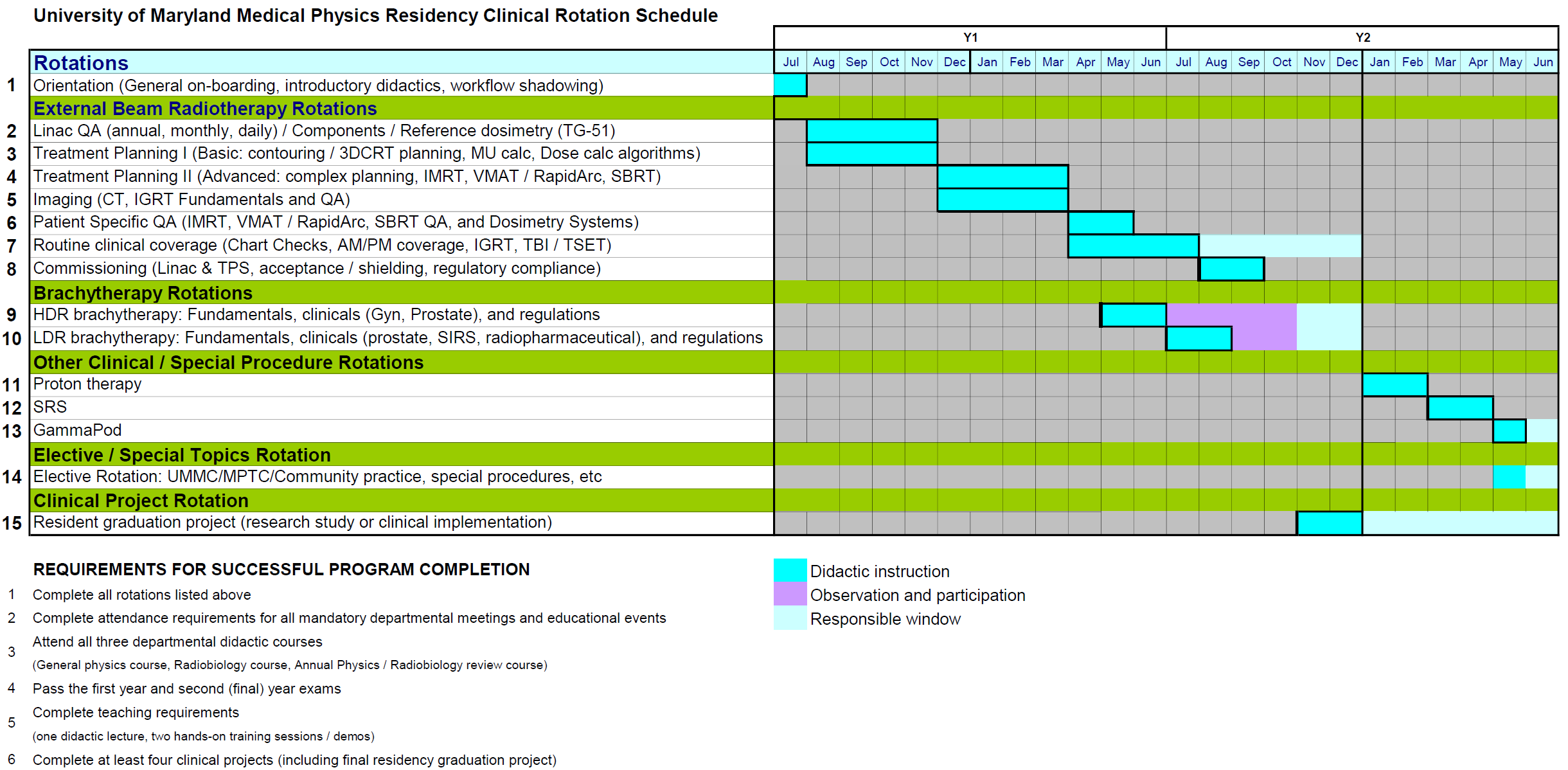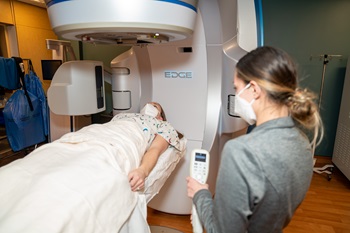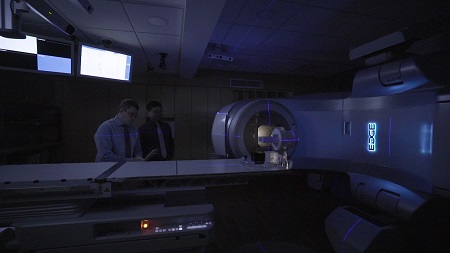Curriculum
During the 24-month training period, residents will complete 15 required core clinical rotations including a graduation clinical project. Additionally, they will engage in other short-term clinically oriented projects as part of clinical training.

Teaching Format

Teaching is carried out through didactic lectures, clinical activities, and numerous teaching conferences, with a strong emphasis on patient care, all under the supervision of full-time staff. The department enjoys state-of-the-art equipment and operates multiple sites both on and off- campus, which include: a main facility in the Gudelsky Building of the University of Maryland Medical Center (UMMC), the Maryland Proton Treatment Center (MPTC), both in downtown Baltimore, Central Maryland Radiation Oncology Center (CMRO) in Columbia, the Kaufman Cancer Center at UM Upper Chesapeake Health in Bel Air, the Tate Cancer Center at UM Baltimore Washington Medical Center (BWMC) in Glen Burnie, the Requard Radiation Oncology Center at UM Shore Regional Health in Easton, and the Radiation Oncology Center at UM Capital Region Medical Center (UM CRMC) in Largo.
There are many intradepartmental and interdepartmental conferences available. It is essential to the success of our teaching program that our residents attend all departmental conferences relevant for each rotation. These conferences are designed to educate trainees at all levels and fulfill important patient care functions on a daily basis. Residents are also expected to present their research or any assigned projects to the department. Some highlights of our teaching format include:
- Didactic lectures
- Clinical labs/ workshops
- Clinical talks (topic-based)
- ABR preparatory sessions (physics rounds and mock orals)
- Guest-attending lectures from within the University of Maryland
- Journal Club (clinical and biological)
- Physics/Radiobiology Talks
- Technology rounds
- Hyperthermia Therapy Practice School
- Visiting professors from outside institutions
- Dedicated EDI training sessions
Research Opportunities
Research opportunities under the direction of selected faculty are available throughout the two-year program. The topics will be focused on clinical questions and address the need of our clinical practice. Each resident completes several clinical projects during residency training and is assigned at least one dedicated project to submit to the AAPM Annual Meeting and Exhibition. Residents typically present their work at multiple national and local professional society meetings.
State-of-the-Art Clinical Training
 The Department of Radiation Oncology at the University of Maryland is strongly committed to maintaining the quality of our educational program. Our department is at the forefront of innovation with its nationally recognized Medical Physics Division and Division of Translational Radiation Sciences (DTRS), which provide outstanding clinical and research experiences for trainees. Trainees have the opportunity to train in our technologies which include, but are not limited to:
The Department of Radiation Oncology at the University of Maryland is strongly committed to maintaining the quality of our educational program. Our department is at the forefront of innovation with its nationally recognized Medical Physics Division and Division of Translational Radiation Sciences (DTRS), which provide outstanding clinical and research experiences for trainees. Trainees have the opportunity to train in our technologies which include, but are not limited to:
- External Beam Radiation Therapy
- External Beam with 12 Varian Linear Accelerators including the TrueBeam Edge, TrueBeam, and Trilogy
- 3DCRT/IMRT/VMAT(RapidArc)
- Stereotactic Body Radiation Therapy (SBRT)
- Stereotactic Radiosurgery (SRS): A dedicated TrueBeam Edge system that reaches submillimeter accuracy level including flattening filter-free (FFF) photon beam, HD-MLC, 6D couch, and surface imaging (Vision RT)
- Low-dose rate (LDR) Brachytherapy
- Radioactive iodine (I-125) seed implantation for prostate cancer
- Radioembolization or Selective Internal Radiation Therapy (SIRT)for liver tumors with SIR-Spheres Y-90
- Xofigo therapy treatment (radioactive radium Ra-223 dichloride) for prostate cancer metastatic to bones.
- High-dose rate (HDR) Brachytherapy
- State-of-art equipment: two Elekta Flexitron afterloaders and one Varian Bravos afterloader
- Intracavitary treatment of Gynecologic cancer with vaginal cylinder, Tandem & Ring, and Tandem & Ovoid applicators
- Interstitial treatment of Gynecologic cancer with Venezia applicator or needles with Syed templates
- SAVI treatment for breast cancer
- HDR brachytherapy for prostate cancer
- HDR brachytherapy for skin cancer
- Hyperthermia Therapy
- Deep Hyperthermia Therapy with BSD-2000 Deep Regional Hyperthermia System
- External and Interstitial Hyperthermia Therapy with BSD-500 Microwave Hyperthermia System
- Respiratory Monitoring and Motion Management
- Breath-hold treatment with Vision RT system for breast cancer patients
- RPM breath-hold or SDX breath monitoring system for thoracic and abdominal cancer treatment
- Abdominal compression with a belt in reducing the respiratory tumor motion for thoracic and abdominal cancer treatment
- Proton Therapy
- Varian ProBeam pencil beam scanning system with 4 rotational gantry rooms and 1 fixed gantry room
- Image-guided proton therapy with on-board imaging (OBI) system, CBCT, and Vision RT
- 6D robotic couch
- Image Guided Radiation Therapy (IGRT)
- MV Portal Imaging
- Varian OBI/CBCT/HyperSight
- Vision RT System/ AlignRT
- Imaging System for Treatment Planning
- Six CT scanners with 4DCT capability
- A Dual energy CT scanner
- An MRI scanner
- Advanced Treatment Planning System (TPS)
- RayStation TPS from RaySearch Laboratories
- Eclipse TPS from Varian
- Oncentra Brachytherapy TPS from Elekta
- VariSeed TPS for prostate seed implant from Varian
- GammaPod Treatment Unit: A dedicated stereotactic radiotherapy device for early-stage breast cancer
- GRID/LATTICE Radiation Therapy
- Single-fraction high dose (10-20 Gy) delivered to bulky malignant tumor
- GRID therapy with photon beam
- GRID therapy with proton beam
- Lattice radiation therapy (3D GRID)
- Total Body Irradiation (TBI)
- Tumor Treating Fields (TTF)
